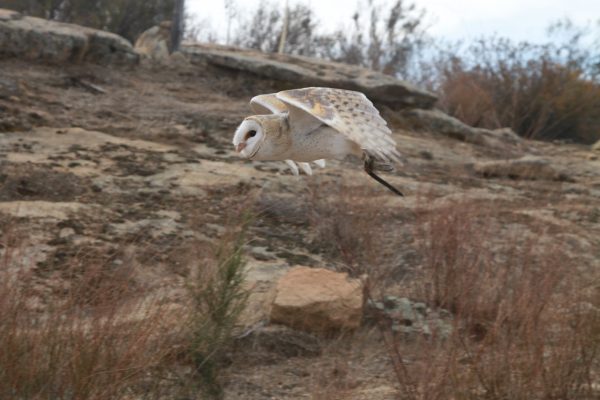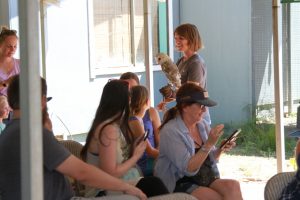
26 Jun Setting up a Barn Owl Nest Box in Your Yard
Barn Owls in Mythology and Pop Culture
At our first ever Family Farm Day at Avian Behavior International on June 2, 2018, we learned how virtually anyone could set up a barn owl nest box in their yard and enjoy not only the thrill of watching a family of barn owls grow up, but reap the benefits of their rodent controlling habits. Barn owls do not migrate and are year-round residents of San Diego county.
family of barn owls grow up, but reap the benefits of their rodent controlling habits. Barn owls do not migrate and are year-round residents of San Diego county.
Barn Owls have found their way into the center of mythology, fairytales, and even popular culture. Their ominous sounding shriek, ghostly underbelly, and silent, floating flight adds to the allure and the mysterious narrative of this nocturnal predator. Even better, barn owls are found on every continent save Antarctica, so their appeal and familiarity is felt not just here in San Diego but around the world.
Barn Owls and Rodenticide

Screenshot of a Good Samaritan trying to help a Red Shouldered Hawk that has been poisoned with rodenticide.
Barn owls are better at catching rodents – mice, rats, gophers, voles, and such – than any man-made technique. That includes snap traps, poisons, sticky traps… every kind of device we have used. It’s also important to note that they can be impacted by
the methods that we employ, like poisons. A rodenticide is designed to not kill a rodent immediately, so when a barn owl, red tailed hawk or other natural predator sees a poisoned animal slowing down, it thinks it has found itself an easy meal. The poison works its way up the food chain and will kill the owl, hawk, dog, cat, bobcat, fox or eagle as well. It’s a very slow death with the animal hemorrhaging blood internally and is a very common cause of death in birds of prey. A friend to the farmers because they are so effective at hunting gophers, which destroy the roots of fruit trees and tunnel up into gardens, barn owls are much appreciated in an agrarian community like San Diego. By encouraging barn owls to come in to our area, we can also help discourage the influx of other unwanted animals, as well, such as snakes. Too many rodents in an area without the awesome predatory skills of a barn owl will encourage snakes, feral cats, and of course, more rodents!
Barn Owl Nests
Barn owls don’t build nests but lay eggs in hollows or cavities, which is why building nest boxes is so effective. They are also quite prolific and can lay eggs several times a year, called clutches. In one clutch they can have anywhere from five to ten eggs. Incubation is three weeks, and the barn owl youngsters begin to fledge around eight weeks of age. A single adult barn owl can eat up to three or four rodents a night, which means hunting for a large family of barn owls can mean they catch around twenty to thirty.
Barn Owl Habitat
Barn owls tend favor open areas, grasslands, and some open woodlands. They avoid dense forests where great horned owls are common, as great horned owls will predate on barn owls. In San Diego County, barn owls will nest in or near palm trees, as they provide excellent habitat for rodents and a high, open perch from which to hunt.
Where is the best place for a barn owl nest box?
There is a reason how barn owls got their name: they like to nest in the rafters, nooks and crannies of barns and outbuildings. We have even come across a family of barn owls rearing young on a stack of hay in a hay barn. If you have the ability to hang a nest box in a barn or outbuilding or on the outside, this is the best place for it. Otherwise, you can hang it on a tree using chain wrapped in hose or rope or on a high sturdy post. The recommended height is fifteen to twenty feet and to have the opening face north to northeast. The most important is to ensure that the nest box is secured so that it does not move and is level. There is no need to put any nesting material inside, as it can get damp or musty and create lung problems for the barn owls. A layer of Ivory soap on the roof will help to discourage bees and wasps from making it their home.
Barn owls tend to prefer their nests away from outdoor flood lights that would make them feel exposed or frighten away their prey. Another thing to keep in mind is that families of barn owls are messy and noisy, so when placing a nest box, mind you and your neighbors’ bedroom windows. They cast out pellets, which are they undigested bones and fur wrapped in a neat but smelly ball.
It can take a couple of years for a barn owl to move into a nest box, but once they do, they will keep returning year after year.
What happens if a baby barn owl falls out of the nest box?
Baby barn owls, known as owlets, can from time to time fall out of the nest. When there are bunches of owlet legs, feet, and wings squirming around, you can imagine how chaotic it can get. It is not a sign of the mamma owl rejecting it, and she will not toss it out again if she smells your scent from putting it back  in there. Au contraire, owls can’t hardly smell at all. The best thing to do is to put it back in the nest and have the parents raise it. It is a federal offense to raise any bird without the proper permits. And even worse, the bird will most likely die if you raise it yourself, whether you release it or not. They have highly specialized needs and if they become imprinted, they do not have the skills needed to make it in the wild. Mom and Dad Bird put in a lot of effort to teach them how to find food and/or hunt. In fact, you may not interfere with the owls in your nest box at all in any way.
in there. Au contraire, owls can’t hardly smell at all. The best thing to do is to put it back in the nest and have the parents raise it. It is a federal offense to raise any bird without the proper permits. And even worse, the bird will most likely die if you raise it yourself, whether you release it or not. They have highly specialized needs and if they become imprinted, they do not have the skills needed to make it in the wild. Mom and Dad Bird put in a lot of effort to teach them how to find food and/or hunt. In fact, you may not interfere with the owls in your nest box at all in any way.
If the owlet falls out and you can’t reach the box, you can put the owlet in a pot, cardboard box or similar receptacle as close to the box as possible and the parents will feed it still. You do not need to put any nesting material in the box. They are biologically designed to extend every effort to help their offspring survive. If the owl is a brancher or a fledgling and is hopping around, and you have a hard time trying to catch it, leave it be. Mom and Dad have an eye on it, and the best thing that you can do is to let them work to take care of their young. For more on what to do when you find a wild baby bird, check out our blog post here.
Constructing a barn owl nest box
There are some great resources to buy or build a barn owl nest box online.
 Are you interested in more Family Farm Days or other events here on the farm? Check out our events calendar and sign up for our email list!
Are you interested in more Family Farm Days or other events here on the farm? Check out our events calendar and sign up for our email list!


